Featured Product Archive
The inventions and products featured on these pages were chosen either for their
uniqueness in the RF engineering realm, or are simply awesome (or ridiculous) enough
to warrant an appearance.
| 1 |
2 |
3 |
4 |
5 |
6 |
7 |
8 |
9 |
10 |
11 |
12 |
13 |
14 |
15 |
16 |
17 |
18 |
19 |
20 |
21 |
<Previous
Next>
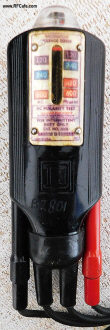
Square D / Wigginton Model 5008 Voltage Tester

Square D Model 5008 Box Top
Sometime in the mid 1970's while working as an electrician, I bought this Square
D / Wigginton (aka the "Wiggy") Model 5008 Voltage Tester. It was probably considered
high tech in the day. It uses a simple solenoid to drive the indicator needle. The
scale begins at 120 volts and ends at 600 volts on the alternating current (A.C.)
side, and 120 through 400 volts on the direct current (D.C.) side. Surprisingly
little information on the 5008 is available on the Web.
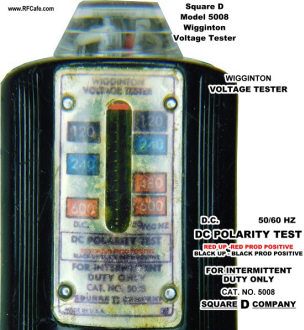
Close-up of the business area of the Square D model 5008 Voltage
Tester. The image is poor due to the plastic cover being crazed.
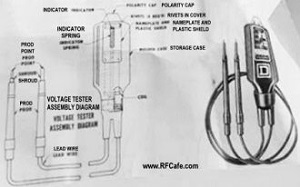
Information sheet for the 5008.

Direct current (D.C.) polarity indicator.
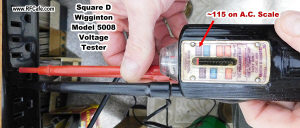
Example of measuring house voltage with the Square D model 5008
Voltage Tester.
The highest voltage I ever measured with it was 480 VAC (3-phase), supplying
a concrete block forming machine in Annapolis, Maryland. It was kind of a spooky
experience. I'm comfortable around 240 VAC, but above that level I worry about compromised
insulation, especially in damp environments.
Even with the availability of much more sophisticated analog and digital multimeters,
this is still my instrument of choice when working on house circuits. It is still
in very nice condition and gets used on a regular basis - as recently as a couple
days ago when adding a couple circuits to my daughter's horse barn.
One nice thing about the solenoid is that you can hear and feel the presence
of an A.C. voltage due to the vibration. Telling the difference between 115 volts
and 230 volts is easy without ever looking at the indicator.
The 5008 can be used to test direct current (D.C.) voltages as well, but I have
never used it for that. There is a ferrite disc in the top plastic window that indicates
which prod is connected to the more positive voltage. Red up means the red-leaded
prod is more positive; black up (the unenergized default) means the black-leaded
prod is more positive. I do not have a D.C. supply with high enough voltage output
to demonstrate the function. I suppose I could fire up the vacuum tube powered
Crosley 03CB Console Radio and measure the 300 VDC on the plates, but that
is too much trouble, and I might break something in the process ;-)
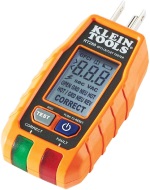
Klein Tools RT250 GFCI Outlet Tester with LCD Display, Electric Voltage Tester
for Standard 3-Wire 120V Electrical Receptacles
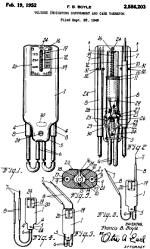
US2586203A patent
Inventor:Francis Boyle
Assignee: Wigginton Co.
When I first starting using the 5008 during classes at the
Lincoln Technical Vocational Center in Annapolis, Maryland, (c1975) ground fault
interrupter (GFI) receptacle and circuit breakers were relatively new, and I don't
recall using them there. If you didn't have one of the plug-in receptacle polarity
testers, the way to check to be sure the neutral wire was on the left and the hot
wire was on the right (ground hole down) was to put one prod of the Square D
5008 Voltage Tester into the right slot (which should be the hot side of the receptacle)
and the other prod into left slot. 120 V should be indicated. Then move the
prod from the left slot to the ground hole and 120 V should also be indicated.
If not, then the neutral and hot wires were reversed on the receptacle. That method
works well for non-GFI circuits, but on GFI-protected circuits the current flowing
through the solenoid coil is enough to cause the protection circuit to trip the
breaker (or receptacle). A digital multimeter (DMM) using a field effect transistor
(FET) input has high enough resistance (impedance) that it does not draw sufficient
current to trip the GFI. Modern plug-in type receptacle polarity testers will not trip a GFI, but my older
model does.
Posted December 16, 2022
|
















